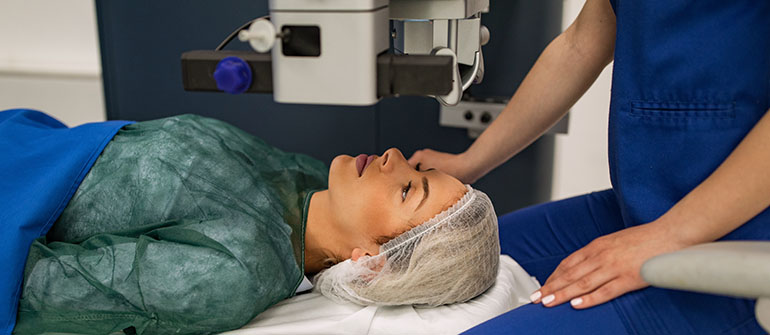
How Does LASIK Work?
How does LASIK work? This is a common question to have when considering laser vision correction. At Greenberg LASIK in Louisville and Indianapolis, we use LASIK to correct a variety of common vision problems, including myopia (nearsightedness), hyperopia (farsightedness), and astigmatism (blurry vision at all distances).
Not only is LASIK one of the safest medical procedures available, but it’s quick and offers long-term results. Below, we explain how LASIK works and what you can expect.
How Does LASIK Work At Greenberg LASIK
Most vision problems are caused by an issue with the way the eye refracts light. To see, the cornea and crystalline lens bend (refract) incoming light rays to focus them on the retina. However, if the cornea is irregularly shaped, this can cause a refractive error and compromise the quality of your vision.
For example, in people with astigmatism, the cornea is curved more steeply in one direction than another. A normal eye should be rounded like a basketball, but this causes it to be shaped more like a football. The irregular shape prevents the eye from focusing light rays on a single point, leading to blurry vision.
Similarly, nearsightedness is often the result of a cornea that’s too long or oval-shaped, while farsightedness occurs when the cornea is too short or isn’t curved enough (the opposite of nearsightedness).
Glasses and contact lenses provide a short-term solution to these common vision problems by using a lens to correct how the eye refract light, thereby improving eyesight (so long as the lens is being worn). But LASIK is a long-term solution because it can correct the root of the refractive error by reshaping the cornea itself.
During LASIK, a small flap is created in the cornea. This can be done using a laser or an instrument known as a microkeratome, depending on the type of LASIK eye surgery you choose to undergo. The flap is pulled back to expose the corneal tissue, which is then reshaped using an excimer laser to allow the eye to properly refract light.
Prior to the procedure, a series of pre-operative tests will be conducted. This data allows the surgeon to create a map of the patient’s cornea, so they know the exact shape it must take during LASIK to correct the refractive error.
At Greenberg LASIK, we offer our patients the most advanced LASIK technology available. We specialize in two types of All-Laser LASIK (also called Bladeless or Blade-free LASIK): Custom Wavefront LASIK and Contoura LASIK.
These types of All-Laser LASIK use wavefront-optimized technology to allow for more precision when mapping the cornea’s surface, which offers patients superior visual results as less risk of side effects. Contoura LASIK specifically uses a high-definition camera to map 22,000 points on the cornea, which is why a slightly higher number of patients achieve 20/15 vision after Contoura compared to Wavefront LASIK. Nevertheless, the majority of patients walk away with 20/20 vision or better following Contoura or Wavefront LASIK.
Though there are different types of LASIK procedures, they all use a laser to reshape the eye’s cornea to correct refractive errors. In general, LASIK has a very high satisfaction rate. One survey by the Food and Drug Administration (FDA) found that 95% of patients are satisfied with the visual results after laser vision correction.
When you come in for a free consultation, our team will determine your candidacy and recommend a LASIK procedure best suited to your needs. We’ll also address any questions or concerns you may have, and make sure you understand how LASIK works. If you’re in Louisville or Indianapolis, book a free consultation with Greenberg LASIK today.